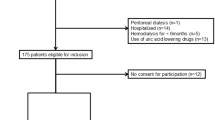Summary
Semicarbazide-sensitive amine oxidase (SSAO) is present in the plasma membrane of several human tissues, e.g. vascular smooth muscle cell adipocytes, and is also found in human serum. Some previous studies on cultured endothelial cells indicate that cytotoxic metabolites (e.g. hydrogen peroxide, formaldehyde acrolein) formed by serum SSAO may cause endothelial injury and subsequently induce atherosclerosis. To investigate the role of this enzyme in the pathogenesis of macrovascular complications in diabetes, a simple and sensitive radiometric procedure was adapted for human serum measurements. Serum SSAO activity of 35 patients with non-insulin dependent diabetes mellitus (NIDDM) and that of 30 controls was determined using [14C]-benzylamine as substrate. The severity of atherosclerosis was assessed by carotid sonography. Diabetic patients with atherosclerosis exhibited a higher SSAO activity compared to diabetic patients without complications (212.91±90.54 pmol/mg protein/h versus 133.17±65.40 pmol/mg protein/h,P<0.04). In diabetic patients without complications, serum SSAO activity was elevated compared to control subjects (133.17±65.40 pmol/mg protein/h versus 91.79±31.70 pmol/mg protein/h,P<0.01). These results suggest that determination of human serum SSAO activity might be a useful marker in the prognostic evaluation of diabetic angiopathy and atherosclerosis.
Similar content being viewed by others
References
Callingham B.A., Barrand M.A. (1987): Some properties of semicarbazide-sensitive amine oxidases. J. Neural. Transm. 23 (Suppl.), 37–54.
Yu P.H., Zuo D.M. (1994): Characterization of human serum and umbilical artery semicarbazide-sensitive amine oxidase (SSAO). Species heterogeneity and stereoisomeric specificity. Biochem. Pharmacol., 47, 1055–1059.
Lyles G.A. (1996): Mammalian plasma and tissue-bound semicarbazide-sensitive amine oxidases: biochemical, pharmacological and toxicological aspects. Int. J. Biochem. Cell. Biol., 28, 259–274.
Raimondi L., Pirisino R., Banchelli G. et al. (1992): Further studies on semicarbazide-sensitive amine oxidase activities (SSAO) of white adipose tissue. Comp. Biochem. Physiol. B, 102, 953–960.
Krieger-Brauer H.I., Kather H. (1995): The stimulus-sensitive H2O2-generating system present in human fat cell plasma membranes is multireceptor-linked and under antagonistic control by hormones and cytokines. Biochem. J., 307, 543–548.
Yu P.H., Zuo D.M. (1993): Oxidative deamination of methylamine by semicarbazide-sensitive amine oxidase leads to cytotoxic damage in endothelial cells — possible consequences for diabetes. Diabetes, 42, 594–603.
Yu P.H., Zuo D.M. (1996): Formaldehyde produced endogenously via deamination of methylamine. A potential risk factor for initiation of endothelial injury. Atherosclerosis, 120, 189–197.
Boomsma F., van Veldhuisen D.J., de Kam P.J. et al. (1997): Plasma semicarbazide-sensitive amine oxidase is elevated in patients with congestive heart failure. Cardiovasc. Res., 33, 387–391.
Boomsma F., Derkx F.H., van den Meiracker A.H., Manin’t Veld A.J., Schalekamp M.A. (1995): Plasma semicarbazide-sensitive amine oxidase activity is elevated in diabetes mellitus and correlates with glycosylated haemoglobin. Clin. Sci. (Colch.), 88, 675–679.
Yu P.H., Zuo D.M. (1992): Inhibition of a type B monoamine oxidase inhibitor, (E)-2-(4-fluorophenethyl)-3-fluoroallylamine (MDL-72974A), on semicarbazide sensitive amine oxidases isolated from vascular tissues and sera of different species. Biochem. Pharmacol., 43, 307–312.
Bradford M.M. (1976): A rapid and sensitive method for the quantitation of microgram quantities of protein utilizing the principle of protein dye-binding. Anal. Biochem., 72, 248–254.
Yu P.H. (1990): Oxidative deamination of aliphatic amines by rat aorta semicarbazide-sensitive amine oxidase. J. Pharm. Pharmacol., 42, 882–884.
Lyles G.A., Holt A., Marshal C.M.S. (1990): Further studies on the metabolism of methylamine by semicarbazide sensitive amine oxidase activities in human plasma, umbilical artery and rat aorta. J. Pharm. Pharmacol., 42, 322–338.
North American Symptomatic Carotid Endarterectomy Trial Collaborators (1991): Beneficial effect of carotid endarterectomy in symptomatic patients until length-grade carotid stenosis. N Engl. J. Med., 325, 445–453.
King G.L. (1996): The role of hyperglycaemia and hyperinsulinaemia in causing vascular dysfunction in diabetes. Ann. Med., 28, 427–432.
Stehouwer C.D.A., Lambert J., Donker A.J.M., van Hinsbergh V.W.M. (1997): Endothelial dysfunction and pathogenesis of diabetic angiopathy. Cardiovasc. Res., 34, 55–68.
Author information
Authors and Affiliations
Rights and permissions
About this article
Cite this article
Mészáros, Z., Karádi, I., Csányi, A. et al. Determination of human serum semicarbazide-sensitive amine oxidase activity: a possible clinical marker of atherosclerosis. Eur. J. Drug Metab. Pharmacokinet. 24, 299–302 (1999). https://doi.org/10.1007/BF03190036
Received:
Issue Date:
DOI: https://doi.org/10.1007/BF03190036




